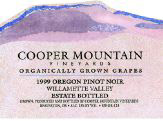Christmas is an odd time of year for wine—assuming you prefer that your wine complement the meal rather than kick-box with it. Chardonnays are overwhelmed by ham and cranberries, turkey is obliterated by cabernet and merlot—so most of your usual wine- pairing impulses are frustrated this time of year. But in my experience, I’ve found that pinot noir—that most misunderstood of red varietals—creates a fine compromise, if not union, between holiday foods and wine.
The pinot noir grape produces a wine both strange and perfect. It smells of tar and roses. Well crafted, its taste is at once of cherries and currants and other sour-sweet fruit. It’s earthy, it’s flowery; one sip of a good pinot and so many layers play across your tongue that it can be like letting multilayered candy dissolve in your mouth.
The grape grows best in its native Burgundy region of France, but it also thrives in the Willamette Valley of Oregon (and, to a lesser degree, the Russian River Valley in Northern California). But if you think that means you can traipse into your local QFC and score a fine bottle of pinot noir for $10, you are sorely mistaken. That’s because this thin-skinned grape is the most difficult of any common varietal to grow and harvest, requiring hand-pruning of the vines, hand-picking of the grapes, and high labor costs all the way around.
This means you won’t begin to see even vaguely decent Oregon pinot until you lay down at least $17 a bottle—and even in the low 20s, you’re barely touching good stuff. This is as it should be: You’ve got to bleed a bit for pinot noir, because pinot noir has bled for you. But it’s still possible to get acquainted with pinot noir without tapping your daily ATM limit.
First, focus your attention on Oregon and France, as most of the reasonably priced pinots coming out of California are thin and unexciting. Second, get good advice. This usually means going to a specialty wine store; some supermarkets have knowledgeable help, but the chance you’ll come across quality pinot in a grocery store is not as good.
If you want to do your own shopping, here are a few tips on bottles to look out for:
1999 Cooper Mountain Pinot Noir (organic), $16: This wine is a steal. You usually don’t get decent pinot at this price, and this pinot has the kind of depth you wouldn’t expect at this price. It won’t be a breakthrough experience, but it will hint at what’s to come.
1999 Rex Hill Pinot Noir, $23.49: While this winery puts most of its efforts into its reserve (small-output, high-priced) wines, they don’t skimp on their entry-level offering: This is a rich, satisfying wine.
2000 Cristom Pinot Noir Mt. Jefferson Cuvee, $25: This single-vineyard pinot is strong without being overwhelmingly tannic. It is a well-balanced wine, with fruit and tannins melding nicely.
2000 Patricia Green Pinot Noir Estate, $27: Destined to become one of the big names in Northwest winemaking, Green makes wines that are well-extracted, fruity, and velvety.
MANY WASHINGTON and California wines, growing well inland in unvarying heat, don’t vary dramatically from vintage to vintage. That’s not true of Ore-gon pinot: The region’s close to the coast, and coastal weather is as given to damp spells as dry. A sizable rain in September can wreak havoc with pinot—the thin-skinned grape sponges up the water and dilutes its flavor. The best recent vintages of Oregon pinot noir have been 1998 and 1999. The 2000 and 2001 are both quite good, but run a bit thin in comparison with the 98s and 99s—much richer, earthier wines, the kind that can hook you on pinot for a lifetime.
French pinot noir, a.k.a. burgundy, is another story. Most burgundy, even from the most famous vineyards, is produced in tiny batches by hundreds of different vintners and distributed (sometimes even blended) by scores of different shippers. You really need the help of a wine-sales professional if you’re not to be disappointed—or, possibly, seriously stung. All I can suggest is that, as in Oregon, the 1999s were astounding, but steer clear of the 00s and 01s.
Oh, and one P.S. for you nontraditionalists: Pinot noir is the wine of choice for holiday salmon, too.









